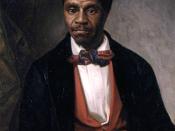It can certainly be argued that it was the issue of slavery that drew the line between North and South in the eyes of many. The tropical climate of the South meant slaves were economically viable in the large-scale production of cotton, linen and tobacco. This meant the slave population was concentrated in the lower South, which contained 59% of slaves in 1860. Although there were slaves in the North, their relative numbers were so few it never became an issue and most Northerners were anti-slavery. However, North and South, with their opposing views remained in a stalemate position until Western Expansion brought new territories, and the question of whether these were to be slave or free. This changed the balance of the pro-slavery and anti-slavery camps. The North feared slavery would spread upwards into further states, a situation they could not allow to happen. It was this potential expansion of slavery that started to bring matters to a head.
Slavery was also important as it brought into question the strength of central government in the States. Apart from the fact that many extremists believed that slavery itself was in direct conflict with the Constitution, it was the divisiveness of the issue that was the threat. Lincoln himself said the states couldn't remain half slave and half free. Presidential campaigns at this time concentrated on the issue of slavery, which was a national and seemingly irresolvable concern. This highlighted its importance and became the emotive rallying point for North and South.
Regional conflicts were evident in the United States from the moment of its founding. At the Constitutional Convention during the summer of 1787, Northern and Southern delegates clashed over questions of slavery. The South, which was more sparsely populated than the North, wanted to count slaves in the population...



Start of the Civil War
You have written a good report but in a "complete" essay which traces the period from the 3/5ths compromise to the start of the Civil War, I would expect to find a listing of any works consulted in support of your details and dates.
4 out of 4 people found this comment useful.